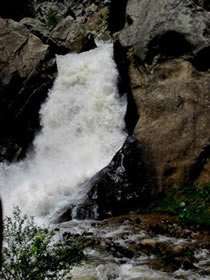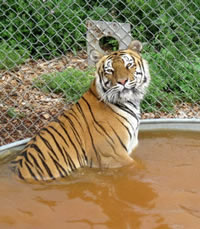 While I visited my son in Colorado last month, I began reading a book by neurophysiologist Dale Purves entitled Brains: How they seem to work. I did this because the studies of brain function are now so numerous and diversified that I knew I needed to upgrade my knowledge. Luckily for me, Purves is one of those rare and wonderful scientists whose background includes a solid grounding in some other discipline that enables them to think outside the scientific box and view problems with a fresh perspective. By the time I realized that Purves was interested in how the brain processes perception, naturally I was hooked because perception plays such an important role in animal behavior as well as human responses to it.
While I visited my son in Colorado last month, I began reading a book by neurophysiologist Dale Purves entitled Brains: How they seem to work. I did this because the studies of brain function are now so numerous and diversified that I knew I needed to upgrade my knowledge. Luckily for me, Purves is one of those rare and wonderful scientists whose background includes a solid grounding in some other discipline that enables them to think outside the scientific box and view problems with a fresh perspective. By the time I realized that Purves was interested in how the brain processes perception, naturally I was hooked because perception plays such an important role in animal behavior as well as human responses to it.
 Purves found himself in the same awkward position many creative thinkers do. Although he was greatly interested in how brains work, he was troubled that the problem was being addressed via an increasingly reductionist process. The prevailing idea that we can understand how something works by knowing more and more about its increasingly tiny components bothered him. In the most general terms, such an approach to perception is based on the belief that there is one “true” reality and the proof of this is based on reproducible measurements of various components of that true reality using increasingly sensitive and sophisticated technology. But as Purves and his colleagues prove, just because data says that an object actually possesses certain brightness or has specific dimensions, shape or color in no way means we will perceive it that way.
Purves found himself in the same awkward position many creative thinkers do. Although he was greatly interested in how brains work, he was troubled that the problem was being addressed via an increasingly reductionist process. The prevailing idea that we can understand how something works by knowing more and more about its increasingly tiny components bothered him. In the most general terms, such an approach to perception is based on the belief that there is one “true” reality and the proof of this is based on reproducible measurements of various components of that true reality using increasingly sensitive and sophisticated technology. But as Purves and his colleagues prove, just because data says that an object actually possesses certain brightness or has specific dimensions, shape or color in no way means we will perceive it that way.
While this may seem ludicrous if you believe that reality is an absolute composed of specific elements that humans and other animals evolved to see exactly as they are, then the idea that we evolved to perceive a species- and even individual-specific relative reality (if you’ll pardon the oxymoron) can be quite threatening. On the other hand, if your academic and/or experiential background leads you to view things ecologically and/or holistically, then it becomes obvious that this must be true.
 For example, as I’m writing this my son’s dog Lumpy is lying on the floor beside me. Thanks to instrumental data, I know two things about Lumpy’s reality. He gains his most intimate picture of his reality via olfaction that enables him to pick up scents I don’t even recognize as real. Second, he’s not a member of a detail visually-oriented species like I am. Among other differences, he has more peripheral vision and is much more sensitive to motion and less sensitive to color than I am. Whereas my kind of vision (now enhanced with corrective lenses) enabled my ancestors to survive in a primate society where the ability to read subtle changes in facial expressions during their diurnal/daylight existence conferred a survival advantage, the success of Lumpy’s depended on their ability to successfully detect the slightest motion while hunting and/or evading predators in crepuscular/limited light conditions. As a result and even though it’s tempting as well as convenient to believe that Lumpy’s reality is the same as mine (let alone those I share with Bamboo the cat and the goldfish), it’s not.
For example, as I’m writing this my son’s dog Lumpy is lying on the floor beside me. Thanks to instrumental data, I know two things about Lumpy’s reality. He gains his most intimate picture of his reality via olfaction that enables him to pick up scents I don’t even recognize as real. Second, he’s not a member of a detail visually-oriented species like I am. Among other differences, he has more peripheral vision and is much more sensitive to motion and less sensitive to color than I am. Whereas my kind of vision (now enhanced with corrective lenses) enabled my ancestors to survive in a primate society where the ability to read subtle changes in facial expressions during their diurnal/daylight existence conferred a survival advantage, the success of Lumpy’s depended on their ability to successfully detect the slightest motion while hunting and/or evading predators in crepuscular/limited light conditions. As a result and even though it’s tempting as well as convenient to believe that Lumpy’s reality is the same as mine (let alone those I share with Bamboo the cat and the goldfish), it’s not.
Depending on how you look at it, the idea that we and our animals perceive different realities can be frightening or liberating. If our view of reality is limited by, for example species- or breed-related prejudices or other fears, then the idea that others of any species don’t share that reality will be quite threatening. When that’s the case and in keeping with last month’s commentary on the role of human narcissism and motivated reasoning, this may result in breakdowns in human-companion animal communication, or worse, attempts to force animals to see or do things our way. Such a limited view of reality also leads to the highly damaging trend toward defining “normal” in increasingly narrow terms that leave more humans and animals in the realm of the “diseased” or “abnormal” with all of the negative effects the mere application of such labels may have on health and behavior.
On the other hand, if we accept that (our) reality isn’t some fixed absolute, the increased elasticity of such a view enables us to be much more objective about our animals’ behavior. Situations that the highly limited absolute view gives us no choice but to label somehow wrong now offer us the opportunity to gain a glimpse of an alternate view of reality we never would have perceived otherwise.
I find it intriguing that we humans are so fascinated by paranormal phenomena of one sort or another to the point that we seek out literature, movies, and other media representations that explore these. At the same time, though, we share our lives every day with multiple species who live in realities that are paranormal compared to ours and we deny that these exists. Does that strike you as odd as it does me? From an ecological standpoint doesn’t it make sense that, just as different physical and time (i.e., nocturnal and diurnal) niches enable multiple species to co-exist in the same physical environment, different perceptual niches/realities would exist for the same reason?
Think about that. Supposed your dog or cat saw the world the same way you did and wanted the same things you did when you wanted them. My guess is that even though we may prefer to treat our animals as if this was true when it’s convenient for us, if it really was we’d either get tired of it or feel threatened by this violation of our realities pretty darn quick.
Nor can I help thinking that one of the reasons why the human-animal bond has survived for so long is because it served and serves as an energy-efficient and nonthreatening way to enable us to recognize that our anthropocentric and ego-centric view of reality isn’t the only one that’s real. Viewed in that light, buying a big-screen television or going to a theater to experience an alternate reality that includes what we consider extra-sensory perceptions when a fur-covered, feathered, or scaled repository of the same sleeps, flies, swims or crawls in our shared environments seems most inefficient. Or maybe in the process of reducing reality to fit within the limits of our fears, we’ve lost the ability to recognize how wonderfully variable it is.
But while this loss may be as permanent as the ability to perceive horizontal or vertical surfaces or anything at all is to those of various species denied this experience during critical periods of brain development, I like to think that anyone willing to study animal behavior can gain an appreciation of this natural phenomenon. And who knows? Maybe one of the reasons the human-animal bond exists is because, in the process of learning to accept differences in animals’ perceived realities as normal, we just might learn to accept those of other humans whose realities we perceive as different from our own.
While this may seem ludicrous if you believe that reality is an absolute composed of specific elements that humans and other animals evolved to see exactly as they are, then the idea that we evolved to perceive a species- and even individual-specific relative reality (if you’ll pardon the oxymoron) can be quite threatening. On the other hand, if your academic and/or experiential background leads you to view things ecologically and/or holistically, then it becomes obvious that this must be true.
Depending on how you look at it, the idea that we and our animals perceive different realities can be frightening or liberating. If our view of reality is limited by, for example species- or breed-related prejudices or other fears, then the idea that others of any species don’t share that reality will be quite threatening. When that’s the case and in keeping with last month’s commentary on the role of human narcissism and motivated reasoning, this may result in breakdowns in human-companion animal communication, or worse, attempts to force animals to see or do things our way. Such a limited view of reality also leads to the highly damaging trend toward defining “normal” in increasingly narrow terms that leave more humans and animals in the realm of the “diseased” or “abnormal” with all of the negative effects the mere application of such labels may have on health and behavior.
On the other hand, if we accept that (our) reality isn’t some fixed absolute, the increased elasticity of such a view enables us to be much more objective about our animals’ behavior. Situations that the highly limited absolute view gives us no choice but to label somehow wrong now offer us the opportunity to gain a glimpse of an alternate view of reality we never would have perceived otherwise.
I find it intriguing that we humans are so fascinated by paranormal phenomena of one sort or another to the point that we seek out literature, movies, and other media representations that explore these. At the same time, though, we share our lives every day with multiple species who live in realities that are paranormal compared to ours and we deny that these exists. Does that strike you as odd as it does me? From an ecological standpoint doesn’t it make sense that, just as different physical and time (i.e., nocturnal and diurnal) niches enable multiple species to co-exist in the same physical environment, different perceptual niches/realities would exist for the same reason?
Think about that. Supposed your dog or cat saw the world the same way you did and wanted the same things you did when you wanted them. My guess is that even though we may prefer to treat our animals as if this was true when it’s convenient for us, if it really was we’d either get tired of it or feel threatened by this violation of our realities pretty darn quick.
Nor can I help thinking that one of the reasons why the human-animal bond has survived for so long is because it served and serves as an energy-efficient and nonthreatening way to enable us to recognize that our anthropocentric and ego-centric view of reality isn’t the only one that’s real. Viewed in that light, buying a big-screen television or going to a theater to experience an alternate reality that includes what we consider extra-sensory perceptions when a fur-covered, feathered, or scaled repository of the same sleeps, flies, swims or crawls in our shared environments seems most inefficient. Or maybe in the process of reducing reality to fit within the limits of our fears, we’ve lost the ability to recognize how wonderfully variable it is.
But while this loss may be as permanent as the ability to perceive horizontal or vertical surfaces or anything at all is to those of various species denied this experience during critical periods of brain development, I like to think that anyone willing to study animal behavior can gain an appreciation of this natural phenomenon. And who knows? Maybe one of the reasons the human-animal bond exists is because, in the process of learning to accept differences in animals’ perceived realities as normal, we just might learn to accept those of other humans whose realities we perceive as different from our own.